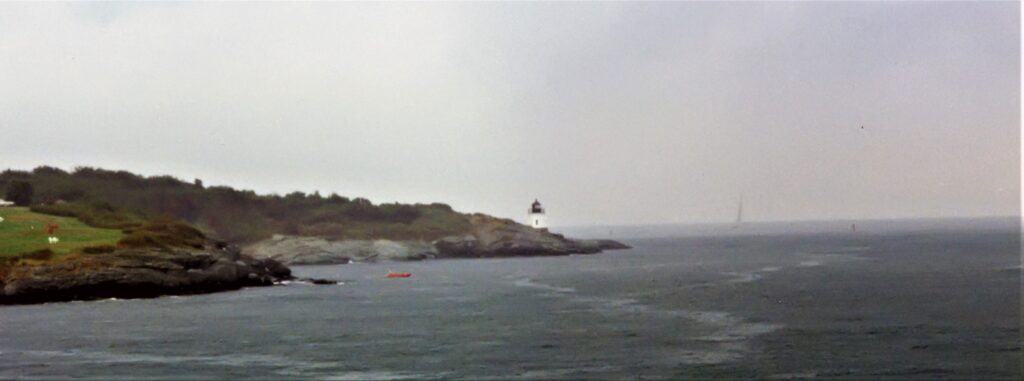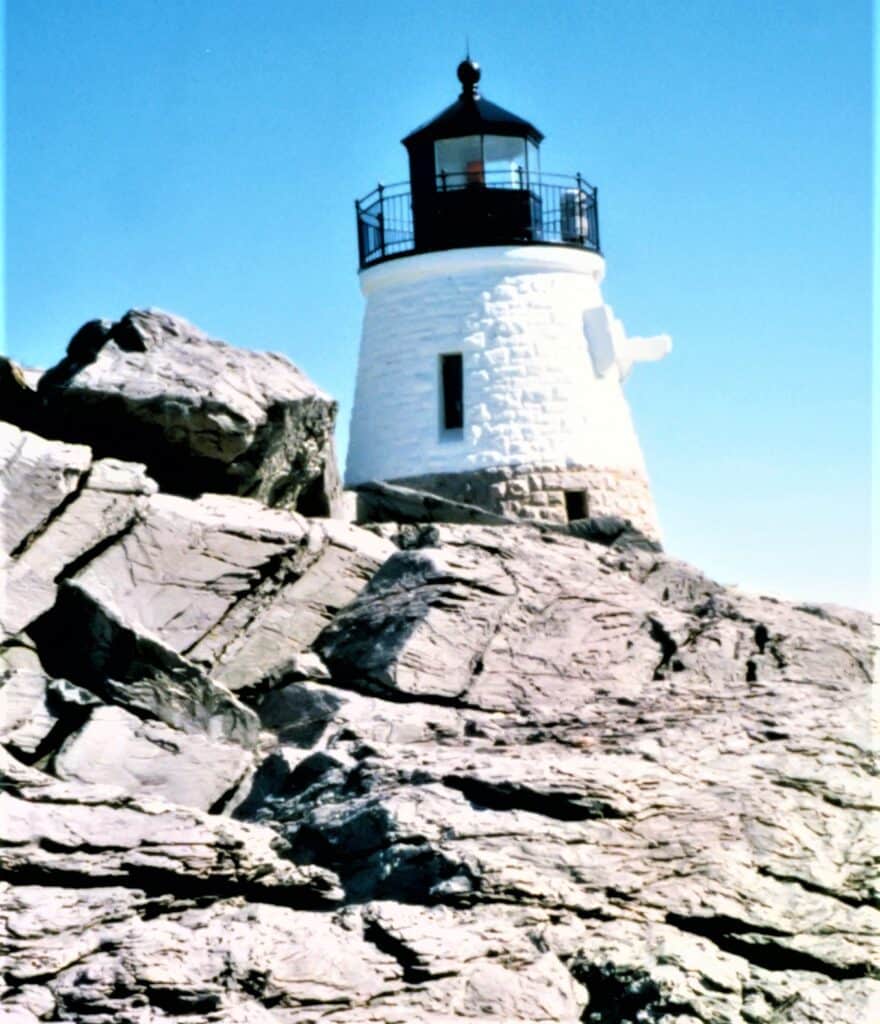Some of the most stunning views in all of New England are at this little lighthouse with a fascinating history.
Castle Hill Lighthouse origin story

Narragansett Bay has been a busy shipping channel for hundreds of years. Newport, at the southern entrance of bay, was a notorious hub for buying and selling slaves, directly leading to the city becoming rich during early colonial times.
As Newport became busier and wealthier it was obvious that another beacon was needed to guide ships into the east passage of Narragansett Bay and the ports dotting the shoreline. In 1869, The Lighthouse Board first requested funds to build a lighthouse at Castle Hill. After a few years of indecision and outcry from locals who had built summer cottages nearby, it seemed the lighthouse would not be built.
Then, scientist and engineer Alexander Agassiz sold a piece of shoreline at Castle Hill for $1. The lighthouse would be built into the rocky face on the waterfront.
Angry Agassiz
But, there was a problem. Agassiz had indeed sold the land The Lighthouse Board, but he had not granted right of way access. Without a land path to shoreline, building the lighthouse would be impossible. There was no place for a ship carrying building supplies to dock.

The impasse between Agassiz and The Lighthouse Board carried on for two years until an agreement was struck and a 2 acre right of way was granted.
Architect Henry Hobson Richardson of Trinity Church in Boston fame, designed the lighthouse. In 1890, the Castle Hill Lighthouse was completed. The gorgeous stone structure blends in so nicely that it looks like it could have been chiseled from the rock facade.
But, completing the lighthouse wouldn’t be the end of the feud between Alexander Agassiz and The Lighthouse Board. Agassiz complained about the noise from the lighthouse’s fog bell, so one year after it was installed, the fog bell was decommissioned.
Then, in 1896, a new fog bell was installed and a new set of complaints were lodged by Alexander Agassiz. In 1898, a screen was installed to deflect the bell’s noise and, it seems, Mr. Agassiz finally had some peace and quiet.
Battle of Point Judith
On April 30th, 1945, Adolf Hitler committed suicide in his bunker in Berlin. Karl Dönitz, per Hitler’s wishes, ascended to become President of the German Reich during the final days of WWII.

Dönitz, knowing the war was lost, ordered his U-boat commanders to stand down.
On May 5th, U-boat 853 was in Rhode Island waters just off Point Judith, not far from Castle Hill. The commander of U-853 either decided to ignore the stand down order or never received it. The German submarine torpedoed and sank the SS Black Point, an American merchant ship. Eleven crewmen and one Navy guard were killed. Nearby ships rushed to the site and rescued 34 men.
American warships were ordered to the area and, shortly after midnight on May 6th, destroyed U 853 using Hedgehog bombs and depth charges. All 55 crewmembers of the German sub were killed.
The next day, Germany surrendered.
Castle Hill lightkeeper Manuel Soares Macedo, whose station at the beacon was only a few miles from Point Judith, saw the SS Black Point sink. It must have been quite a terrifying sight as one of the U-boat’s torpedoes blew off the entire stern of the Black Point.
Later, when some of the wreckage of U 853 was recovered, the submarine’s propellers were put on display at the Castile Hill Lighthouse. Today, they are housed at the Newport Naval Station.
Visiting Castle Hill
The first time I went to Castle Hill Lighthouse, it was accessible by a rickety wooden staircase. That was replaced by a concrete staircase in 1992. But, caution should be exercised all the same. The rocks and passage can get slippery, especially during high tide or when it rains.
A visit to the lighthouse is certainly worth it. You’ll get to see the stone structure up close and you’ll be rewarded with spectacular views of the bay and the Pell Bridge connecting Aquidneck and Conanicut Island.
The best way to get to the lighthouse is to park at the Castle Hill Inn and take the short footpath to the beacon. During the time of Covid, however, the folks at Castle Hill Inn are restricting access to their parking lot. Only people dining at the inn or staying overnight can park there.
If you want to see the lighthouse and are not a patron of the Castle Hill Inn, there are a couple options. You can park at the Castle Hill Cove Marina and follow the footpath to the lighthouse.
Or, you can park at Brenton Point State Park and walk along the shoreline to the lighthouse. If you choose to do that be aware that in Rhode Island, the shoreline is a public right of way (one of the many reasons I love RI!) but only to the high tide water mark. So, go at low tide and be aware of bad weather, slippery footing, and rogue waves.
Castle Hill Inn
The Castle Hill Inn is one of Newport’s best high end restaurants and overnight stays. Originally built by Alexander Agassiz (remember him? the guy who sold the land to The Lighthouse Board for $1?) as a summer getaway and laboratory, it is now enjoyed by thousands of guests and customers every year.

The dining room has huge banks of windows which afford sweeping views of the bay. And, the food is pretty great as well. I had a friend tell me she decided to marry her then-boyfriend after he took her to have a meal there (I think she was only partially kidding).
There is also a nice bar, but if you want to enjoy the magnificence of the Castle Hill Inn without spending a fortune, try this tip. During the summer, Adirondack Chairs are set out on the lawn of the property. You’ll need to arrive early, but if you snag one of these chairs, you can order a cocktail and marvel at the 180 degree views of Narragansett Bay. If the chairs are occupied, there’s an outdoor terrace bar with equally stunning views.
About the Author

Brent Petersen is the Editor-in-Chief of Destination Eat Drink. He currently resides in Setubal, Portugal. Brent has written the novel “Truffle Hunt” (Eckhartz Press) and the short story collection “That Bird.” He’s also written dozens of foodie travel guides to cities around the world on Destination Eat Drink, including in-depth eating and drinking guides to Lisbon, Porto, Sintra, Monsaraz, and Evora in Portugal. Brent’s podcast, also called Destination Eat Drink, is available on all major podcasting platforms and is distributed by the Radio Misfits Podcast Network.
